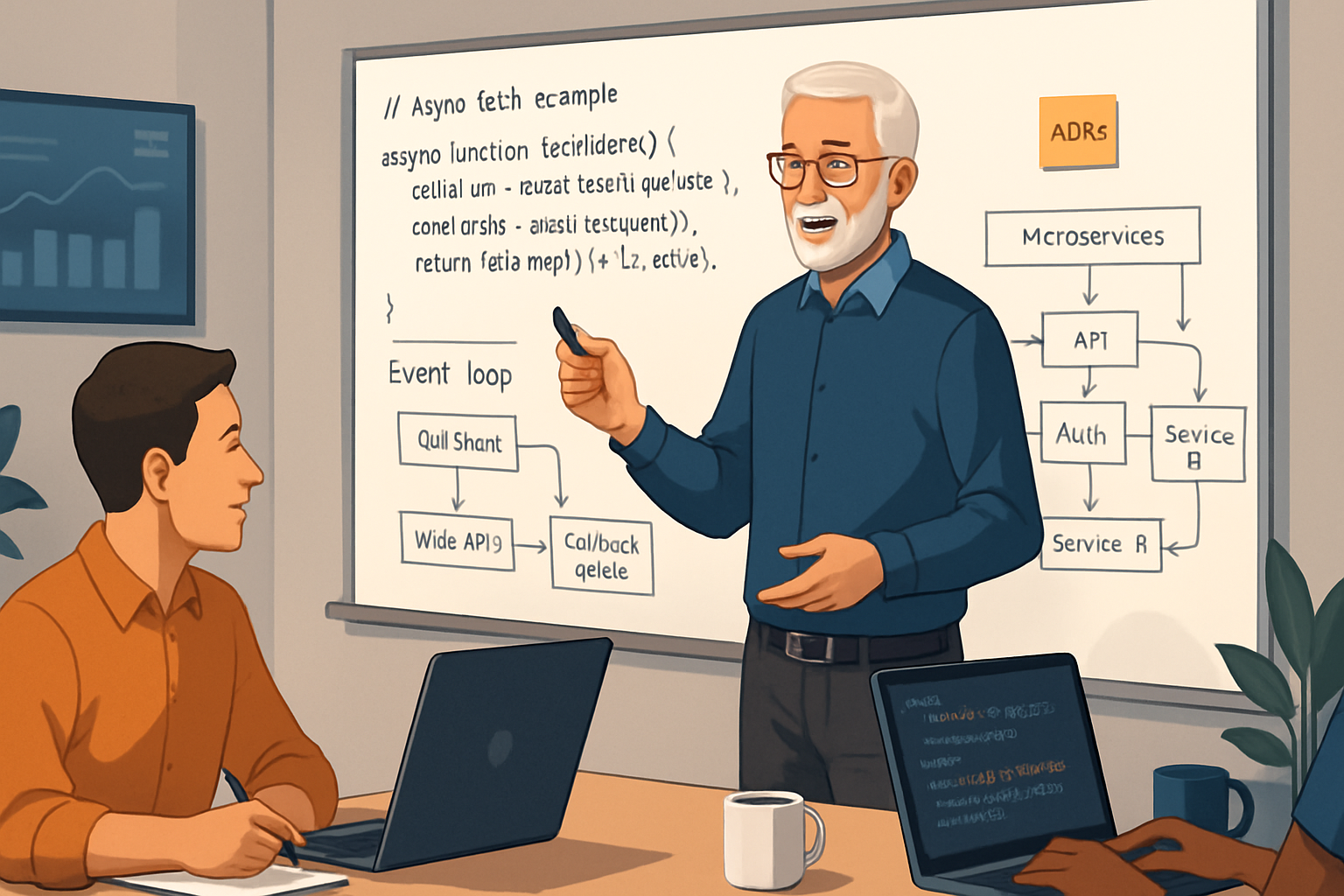· career · 7 min read
From Developer to Tech Lead: Navigating the Challenges of Leadership in JavaScript
Concrete strategies, templates and routines to help experienced JavaScript developers transition into effective tech leads - from delegation and decision-making to feedback, architecture and career growth.

Introduction - what you can achieve
You can become the kind of tech lead people trust to ship reliable systems, grow engineers, and steer technical direction - without losing your love of code. This article gives you the practical strategies, meeting rhythms, decision frameworks, and copy‑paste scripts to navigate the most common challenges developers face when they step into a tech lead role.
You’ll walk away with actionable routines (1:1 agendas, code‑review patterns, prioritization checklists) and a clear mental model for shifting from “I build features” to “I enable teams to build features well.” Read on if you want to make that transition faster and less painful.
Why the transition is hard (but worth it)
As a senior developer you were rewarded for producing. As a tech lead you are rewarded for producing leverage. That change is subtle and often uncomfortable:
- You trade some individual output for multiplied output through others.
- You move from tactical to strategic thinking.
- You must make decisions with imperfect information and live with the consequences.
The good news: these are learnable skills. And-surprising to many-your technical credibility remains an asset. The real trick is learning when to apply it and when to step back.
Core mindset shifts
- From “I do” to “We do.” Your goal is to enable the team to succeed without you being the bottleneck.
- From certainty to probabilistic judgment. Decisions will often be tradeoffs; make them explicit.
- From code correctness to system correctness. Consider reliability, operability, observability, and maintenance costs.
Common challenges and how to handle them
- Influence without authority (communication and trust)
The problem: You may not be the formal manager, yet you need to steer choices across peers, PMs, and stakeholders.
Strategies:
- Build relationships first. Spend time understanding product goals and individual incentives.
- Use data and experiments. Propose measurable pilots, not just opinions.
- Frame proposals in terms of user impact, risk, and time-to-value.
Try this script in cross-functional conversations:
“Here’s the problem I’m seeing. My proposal is X. The benefit is Y. The downside / risk is Z. If we want to test quickly we can ship a canary for two weeks and measure A and B.”
References: see Influence Without Authority for tactics on persuasion and coalition building.
- Delegation and trust (stop being the bottleneck)
The problem: Developers step into tech lead roles and continue doing the heavy lifting rather than enabling the team.
Strategies:
- Use the “Delegate, Coach, Do” checklist for tasks: can someone on the team (with support) do this? If yes, delegate. If the task is a growth opportunity, pair program then step back.
- Break big tasks into clear, small deliverables with acceptance criteria.
- Practice letting code go. Use code review as a coaching tool, not a gate to your preferences.
Delegation template (PR / ticket):
- Goal: what success looks like
- Constraints: known limits (backwards compatibility, perf budgets)
- Acceptance criteria: concrete tests/observability checks
- Timeline: expected check-ins
- Balancing architecture and delivery
The problem: You oscillate between shipping features and designing long‑term architecture. Overinvest and nothing ships. Underinvest and technical debt explodes.
Strategies:
- Timebox architecture: create a 1–2 sprint discovery phase with clear outcomes: prototypes, performance targets, or decision logs.
- Use lightweight decision records (ADR - Architecture Decision Records) to capture tradeoffs and rationale.
- Prioritize evolutions by cost of delay. If refactor unlocks many features, raise its priority.
Useful resource: Team Topologies and the ADR pattern.
- Hiring and team growth
The problem: You’re asked to interview, hire, or mentor without a hiring rubric or onboarding plan.
Strategies:
- Define hiring criteria before interviewing (skills, signals, culture add).
- Use collaborative interviews with a consistent scorecard.
- Create a 30/60/90 onboarding plan for new hires: clear first tickets, mentors, and check‑ins.
Interview scorecard example:
- Problem solving (1–5)
- Systems design (1–5)
- Code quality and clarity (1–5)
- Collaboration and communication (1–5)
- Overall fit / hire (yes / maybe / no)
- Giving feedback and handling performance conversations
The problem: Feedback is awkward. People avoid it until issues compound.
Strategies:
- Give frequent, specific feedback in small doses. Use the SBI model (Situation - Behavior - Impact) for clarity.
- Prefer growth framing: “This is a skill to improve; here’s how we’ll support you.”
- Use regular 1:1s to surface concerns early.
Feedback script (SBI):
- Situation: “In yesterday’s standup when we discussed X…”
- Behavior: “You interrupted and steered the conversation toward Y…”
- Impact: “That made it harder for others to share; we lost a perspective.”
- Suggestion: “Next time, could you hold your point for the end so we can get everyone’s input?”
Reference: Radical Candor offers a practical framework for caring personally while challenging directly.
- Context switching and time management
The problem: The role involves many interruptions: meetings, escalations, design reviews.
Strategies:
- Block focus time for deep work and protect it on the calendar.
- Batch similar tasks (office hours, pairing sessions, interview blocks).
- Use the 2‑minute rule for tiny interruptions; otherwise add them to a triage backlog.
- Staying technical without getting lost in details
The problem: Either you stop coding entirely and lose credibility, or you code so much you stop leading the team.
Strategies:
- Reserve 10–20% of your time for hands‑on coding (bugfixes, prototypes, critical PRs).
- Use pairing and lightweight mobbing to keep visibility into the codebase without single‑handed ownership.
- Focus your technical contributions on high‑leverage areas: core libraries, developer experience, CI/CD, observability.
Decision frameworks and rituals that save time
- DACI / RACI for decisions: Clarify who is Driver, Approver, Contributor, Informed.
- ADRs (Architecture Decision Records): Keep decisions discoverable.
- DRIs (Directly Responsible Individual): For operational ownership.
Meeting rituals (practical):
- Weekly 1:1s (30–45 min) with a simple agenda: wins, blockers, growth, feedback, action items.
- Weekly tech sync (30 min): architecture signals, upcoming changes, and technical debt triage.
- Biweekly planning with PMs: align on roadmap tradeoffs and technical constraints.
1:1 agenda (copyable)
- Quick personal check-in (2–3 min)
- Wins since last time (3–5 min)
- Blockers & help needed (5–10 min)
- Career / growth conversation (10–15 min)
- Action items & next steps (3–5 min)
Code review as leadership
- Use PR reviews to teach, not to gatekeep. Start reviews with a summary of what you’re looking for: “Focus on correctness and performance; less concerned about naming here.”
- Prefer questions that provoke thinking: “Did you consider X?” instead of “This is wrong.”
- Highlight a single improvement and a single positive takeaway in every review.
Code review comment templates
- Praise + small change: “Nice approach - makes the flow clear. Could we add a unit test for edge case X?”
- Questioning: “What happens when input is null? Is that possible here?”
- Suggestion: “Consider extracting this into a small helper to make the intent clearer.”
Prioritization tools
- RICE (Reach, Impact, Confidence, Effort) for feature prioritization.
- Cost of Delay for architectural work.
- MoSCoW (Must, Should, Could, Won’t) for scope negotiation.
Measuring your impact
You can’t manage what you don’t measure. Here are useful signals for a tech lead:
- Team delivery predictability (velocity variance, on‑time delivery).
- Quality signals (defect escape rate, mean time to restore).
- Developer experience (onboarding time, PR cycle time, developer satisfaction surveys).
- Team growth (skill distribution, promotion velocity).
Link these metrics to the business outcomes (time to revenue, customer retention) when discussing them with stakeholders.
Concrete weekly checklist for a tech lead (copyable)
- 1:1s scheduled and prepared
- At least one code review with teaching intent
- One hiring / interviewing task completed (if hiring)
- One architecture/tech debt decision or ADR updated
- Blocked tickets triaged and delegated
Common pitfalls to avoid
- Micromanaging. If you find yourself rewriting PRs, ask whether you’re enabling the person or doing the work for them.
- Overcommitting to coding sprints at the expense of team health.
- Treating technical decisions as personal achievements. The best decisions survive even if you leave.
Resources and further reading
- Camille Fournier - The Manager’s Path (practical guide for engineers moving into leadership): https://www.oreilly.com/library/view/the-managers-path/9781491973897/
- Kim Scott - Radical Candor (feedback framework): https://www.radicalcandor.com/
- Matthew Skelton & Manuel Pais - Team Topologies (team design): https://teamtopologies.com/
- DORA Accelerate book (research on high performance engineering): https://itrevolution.com/book/accelerate/
- Influence Without Authority (tactics for persuasion): https://www.amazon.com/Influence-Without-Authority-Allan-Cohen/dp/0471108421
Conclusion - what to focus on first
If you do one thing after reading this: start regular 1:1s and make delegation explicit. Those two moves will surface the majority of the problems you need to solve: communication gaps, knowledge transfer, and performance issues. From there, add ADRs and a simple decision framework (DACI) to make choices visible.
Leadership isn’t about being the smartest person in the room. It’s about making the room smarter. If you enable your team to ship faster, safer, and with more ownership, you will have done the highest‑leverage work possible as a tech lead.
References
- Influence Without Authority - Allan Cohen & David Bradford: https://www.amazon.com/Influence-Without-Authority-Allan-Cohen/dp/0471108421
- Radical Candor - Kim Scott: https://www.radicalcandor.com/
- The Manager’s Path - Camille Fournier: https://www.oreilly.com/library/view/the-managers-path/9781491973897/
- Team Topologies - Matthew Skelton & Manuel Pais: https://teamtopologies.com/
- Accelerate - Nicole Forsgren, Jez Humble, Gene Kim: https://itrevolution.com/book/accelerate/



